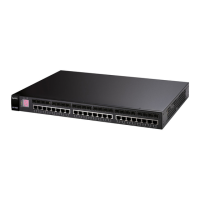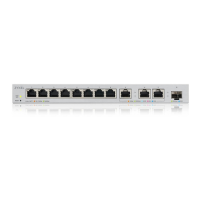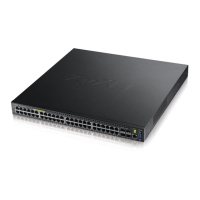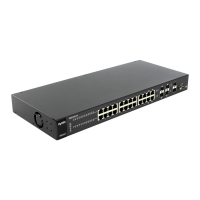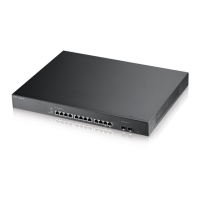XGS4600 Series User’s Guide
121
CHAPTER 9
VLAN
9.1 Overview
This chapter shows you how to configure 802.1Q tagged and port-based VLANs.
The type of screen you see here depends on the VLAN Type you selected in the Switch Setup screen
which is only available in standalone mode. The Switch does not support port-based VLANs in stacking
mode.
9.1.1 What You Can Do
• Use the VLAN screen (Section 9.3 on page 124) to view and search all static VLAN groups.
• Use the VLAN Detail screen (Section 9.3.1 on page 125) to view detailed port settings and status of the
static VLAN group.
• Use the Private VLAN Status screen (Section 9.4 on page 126) to view all private VLANs created on the
Switch.
• Use the Static VLAN Setup screen (Section 9.6 on page 128) to configure a static VLAN for the Switch.
• Use the VLAN Port Setup screen (Section 9.7 on page 130) to configure the static VLAN (IEEE 802.1Q)
settings on a port.
• Use the Subnet Based VLAN Setup screen (Section 9.8 on page 132) to set up VLANs that allow you to
group traffic into logical VLANs based on the source IP subnet you specify.
• Use the Protocol Based VLAN Setup screen (Section 9.9 on page 135) to set up VLANs that allow you
to group traffic into logical VLANs based on the protocol you specify.
• Use the Voice VLAN Setup screen (Section 9.10 on page 138) to set up VLANs that allow you to group
voice traffic with defined priority and enable the Switch port to carry the voice traffic separately from
data traffic to ensure the sound quality does NOT deteriorate.
• Use the MAC Based VLAN Setup screen (Section 9.11 on page 140) to set up VLANs that allow you to
group untagged packets into logical VLANs based on the source MAC address of the packet. This
eliminates the need to reconfigure the Switch when you change ports. The Switch will forward the
packets based on the source MAC address you set up previously.
• Use the Vendor ID Based VLAN Setup screen (Section 9.12 on page 141) to set up VLANs that allow
you to group untagged packets into logical VLANs based on the source MAC address of the packet.
You can specify a mask for the MAC address to create a MAC address filter and enter a weight to set
the VLAN rule’s priority.
9.1.2 What You Need to Know
Read this section to know more about VLAN and how to configure the screens.
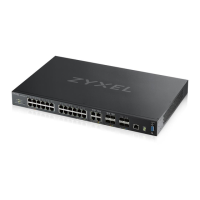
